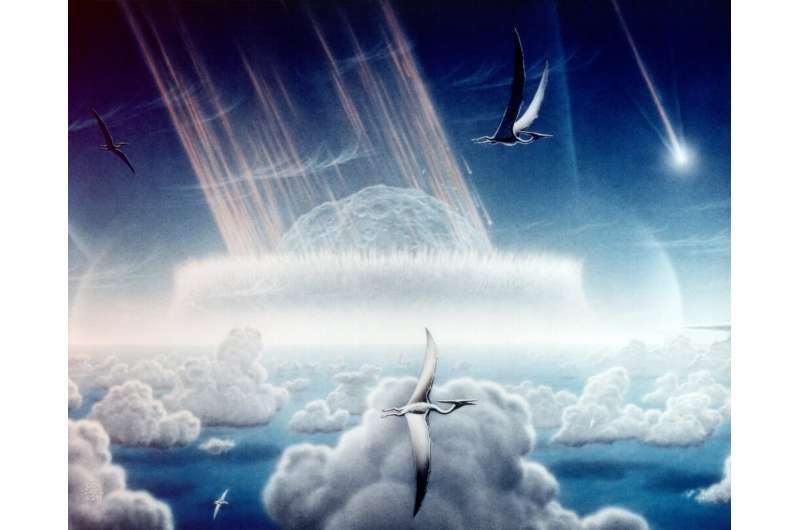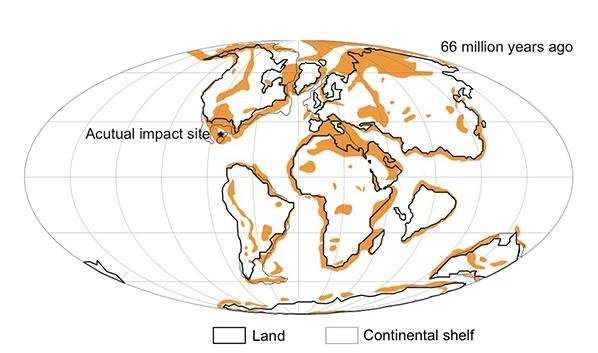November 10, 2017 report
New analysis of Chicxulub asteroid suggests it may have struck in vulnerable spot

(Phys.org)—A pair of researchers at Tohoku University has found evidence suggesting that if the asteroid that struck the Earth near Chicxulub 66 million years ago had landed almost anywhere else, it would not have been nearly as destructive. In their paper published in the journal Scientific Reports, Kunio Kaiho and Naga Oshima suggest that had the asteroid struck another part of the planet it is likely the dinosaurs would have survived.
Scientists around the world have reached a consensus regarding the reason that the dinosaurs (except for bird relatives) went extinct—a large asteroid struck the Earth just off what is now the Yucatan peninsula, hurling so much soot and other material into the atmosphere that the planet became too cold (for approximately three years) for the dinosaurs and most other land animals to survive. But now, it appears that they might have survived had the asteroid struck almost anywhere else.
To learn more about the event that had such a huge impact on the history of our planet, Kaiho and Oshima used a computer to analyze multiple data sources surrounding the impact and the location where it struck—the resulting simulation showed how much soot would have been generated based on the amount of hydrocarbon material in the ground near the impact site. Such hydrocarbons would include not just oil or coal deposits, but other rocks that also contained oil—more hydrocarbons would mean more soot and gases making their way into the atmosphere. The research pair also created a map showing surface hydrocarbon densities across the globe at the time.
They found that the site where the asteroid struck was particularly dense in hydrocarbons—87 percent of the planet surface was less dense. That means, they claim, that if the asteroid had struck a place where it was less dense (which would have been almost anywhere else), much less soot would have been generated, and thus, the planet would not have cooled as much. And if the planet had not cooled so much, the dinosaurs might have survived, and that might have meant that we humans would never have had a chance to evolve.

More information: Kunio Kaiho et al. Site of asteroid impact changed the history of life on Earth: the low probability of mass extinction, Scientific Reports (2017). DOI: 10.1038/s41598-017-14199-x
Abstract
Sixty-six million years ago, an asteroid approximately 9 km in diameter hit the hydrocarbon- and sulfur-rich sedimentary rocks in what is now Mexico. Recent studies have shown that this impact at the Yucatan Peninsula heated the hydrocarbon and sulfur in these rocks, forming stratospheric soot and sulfate aerosols and causing extreme global cooling and drought. These events triggered a mass extinction, including dinosaurs, and led to the subsequent macroevolution of mammals. The amount of hydrocarbon and sulfur in rocks varies widely, depending on location, which suggests that cooling and extinction levels were dependent on impact site. Here we show that the probability of significant global cooling, mass extinction, and the subsequent appearance of mammals was quite low after an asteroid impact on the Earth's surface. This significant event could have occurred if the asteroid hit the hydrocarbon-rich areas occupying approximately 13% of the Earth's surface. The site of asteroid impact, therefore, changed the history of life on Earth.
Journal information: Scientific Reports
© 2017 Phys.org





















